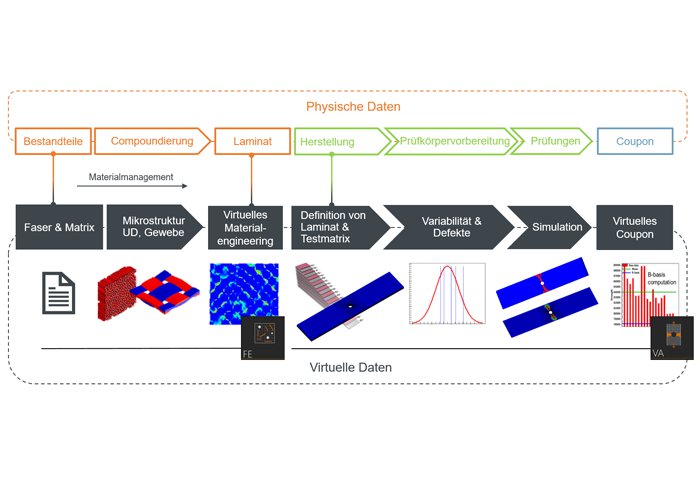
Advanced analyses of microstructures using composites
ESPECIALLY FOR OUR USERS
Versatility, high strength, excellent weight and application-related properties are just some of the features offered by composites in technical products. In order to optimally develop composite components, a deep understanding of the material behavior must be available. Here, the microstructure plays the decisive role, as the material behavior can change fundamentally. Thus, there should be a basic understanding of the behavior between, for example, a fabric or unidirectional profile, which can be extended by means of micromechanical material modeling.
To achieve a correct design of composite structures, a deeper understanding of the material behavior is essential. Composites do not differ exclusively in their manufacturing process and the associated microstructure, but are also dependent on the filler or fiber material used. In the classic injection molding process, short glass fibers are increasingly used, which cause the anisotropic material behavior due to their orientation. Composites, on the other hand, can have different shapes, structures, layer structures and fillers.
In general, short or long glass fibers are not used in the area of unidirectional profiles as well as fabrics, since the required stiffness and strength cannot be met. Continuous fibers are classically used for these applications. This allows the production of semi-finished products, so-called prepregs, with very high stiffnesses and strengths. Prepreg is the abbreviation for "pre-impregnated fibers". It refers to a semi-finished product consisting of continuous fibers and an uncured thermoset plastic matrix. In a further process step, these are used as reinforcement to produce components with high requirement profiles. On the other hand, corresponding continuous fiber-reinforced systems are produced by means of winding processes. Applications include tank systems, for example.
Material engineering can be used to gain a deeper understanding of new material systems. On the one hand, material parameters of the matrix and the reinforcing material must be transferred to a material model and calibrated via reverse engineering, if necessary; on the other hand, these material models enable deeper analyses of the material behavior, taking into account the microstructure. Due to the added value of information about the material behavior, the layer structure of UD profiles as well as the weaving steps of a fabric or tape can be optimized for the application. This knowledge can be gained through FE-analysis within Digimat, as well as the implementation of the microstructure through modeling, as well as experimental data (CT-scan). Holistic optimizations of material systems tailored to the application can be implemented quickly and easily.
In addition to the optimization of the material systems with respect to the microstructure, it is possible to analyze these systems in a coupling to the general structural analysis on the component level. Through a coupling with the complex material map, a validation on the product takes place. Weak points, critical areas, verification of material performance as well as failure behavior are in focus. With the help of this simulation chain on the one hand a holistic design of components and on the other hand component optimization can take place. Likewise, optimizations can be viewed differently, since they can aim at performance on the one hand and weight savings on the other. Of course, many other points are often in focus, such as failure behavior, service life, NVH, influence of temperature or influence of high strain rates (crash). All these points can be illuminated in greater depth with material engineering and finally validated numerically.
Would you like to know more?
Please contact us: + 49 (0)241-565 276-0 or send us an email to info@simpatec.com .
